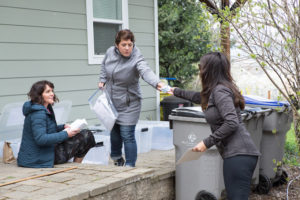Covid-19 Tests the Columbia Gorge’s Culture of Health
Perhaps it is because the Columbia Gorge region of Oregon-Washington is only a three-hour drive from Seattle. Perhaps it is because Oregon is a Medicaid expansion state, and we are generally attuned to both health and care. Whatever the reason, we were paying close attention to the first Covid-19 hotspot in Seattle.
Most of us didn’t know much about the virus ravaging a senior living facility in Kirkland, Washington. As the days went on, we learned more and more. The first case of community transmission — not related to international travel — in California, an eight-hour drive south. Then, the sudden spread of infections, like a windshield hit by a rock spiderwebbing out in all directions from Seattle to the north and California to the south.
A Diverse Region Known for Collaboration
Geographically, the Columbia Gorge region is the nation’s only National Scenic Area. Economic drivers include agriculture (fruit orchards), hi-tech (Google Data Center and Boeing), and tourism (outdoor adventure sports).
Our population is approximately 75,000 over five counties: Hood River, Wasco, and Sherman counties in Oregon and Klickitat and Skamania counties in Washington. Within that total, 25% are Latino, and 15% are enrolled in Medicaid. Of the 9,000 K-12 students, 70% are eligible for free/reduced meals, and 25% are Ever English Learners.
In 2016, the region was awarded the Robert Wood Johnson Foundation Culture of Health Prize, based largely on our ability to identify community needs and solutions through collaboration, innovation, and engaging all segments of the community.
I knew we would need to rely on these skills and practices to address the impacts of Covid-19. My job is to support organizations trying to keep people healthy using a broad definition of health, including social and economic factors. In the first week of March, the news was ramping up, and so was my anxiety. Something was coming, but I didn’t know what problems it would create.
The more I talked with community partners, the more my anxiety grew. What could we do, what should we do? Something, of course, but what. We didn’t have anything concrete to react to. No shortages, no cuts, no lost anything…yet. No data. And, then, overnight everything changed.
Feeling the Impacts
On March 12, Oregon Gov. Kate Brown closed all public schools in Oregon for two weeks. Then, five days later, she closed schools for six weeks. Suddenly, we were all in it, together. And, just as suddenly, we had something concrete to react to.
School closures impact everyone. The impact in rural communities is magnified by a lack of resources. The impact is even more magnified for low-income and people of color in rural areas.
Food for students was the first big, identifiable impact. For many low-income students, school lunch and the snacks provided before and after school constitute the bulk of food they get every day. I reached out to several school districts. They were all making plans to continue providing food for students; some have created multiple pick-up locations, others are driving bus routes and dropping off food for students. Their work continues.
A lack of Personal Protective Equipment (PPE) jumped up from obscurity. The four small hospitals in the region faced limited supplies and very little clout to get more. Individual community members quickly got to work partnering with local businesses who converted operations to PPE production: local wind surfing manufacturers shifted processes and began making masks and face shields; two local distilleries changed recipes to make hand sanitizer. Their work continues. Distribution is now an unsolved problem.
Continuing Troubles with Communication
On March 22, Oregon’s governor ordered the closing of businesses, restaurants, etc. This included nonprofit organizations, and expanded the problem. Now, community-based organizations, which don’t have the most up-to-date technology to begin with, suddenly have to figure out old laptops, old phones, maybe iPads that are not connected to anything outside of the office. How are they supposed to work if they can’t even open a computer? This problem continues.
Wait… forget the computers, how are they supposed to check in on their clients? With the highest per capita rate of Community Health Workers (CHWs) in the country, much of our work is done through home visits and face-to-face interactions in the community. The governor told us to Stay Safe, Stay Home. But what about our clients, how are we supposed to…?
Communication is a top issue. Are Spanish-speaking community members getting accurate, and up-to-date information? Can you call your clients? Yes, but, with kids at home all day, their data plans are running out. So, texting is spotty. The single Spanish-language radio station is broadcasting, but it is difficult to physically arrange shows with the social distancing requirements. Some CHWs are simply driving to houses, honking the horn, and talking to clients through windows and doors. This issue continues.
Besides how we communicate, what are we communicating? Do we even have the most accurate, up-to-date information in Spanish? Who can convert that to plain language and then, into Spanish? The health departments have up-to-date info on their websites, and it’s in Spanish. That is good, but the lack of technology and data plans means many low-income families can’t access it. This issue continues.
Seeking Income, Distributing Funds
As I write this, we have rolled through the last two weeks of March under our school closures; Stay Home, Stay Safe orders; and closed businesses. We are now into April. Many people, low-income and people of color included, are not getting their first lost paycheck. They don’t have the money to pay April’s bills, including rent, utilities, phone, and food. Thankfully, Oregon instituted a 90-day moratorium on evictions, and most utility companies said they will not shut off utilities for nonpayment. But, what happens after the 90 days.
Lost income is now racing to the top of the needs list. Businesses, including nonprofits, can apply for payroll and emergency money through the CARES Act, signed into law last month. That process is cumbersome and includes a lag time. Most foundations have empowered nonprofits to convert program grants to general operating grants. That helps keep some staff employed. This is the issue we are dealing with today and tomorrow.
In response to ever-rising issues, individual community members with financial means call to ask where their money is needed. Some write checks directly to nonprofits; others donate to the Community Response Fund, a partnership between the Healthy Gorge Initiative and United Way-Columbia Gorge to support nonprofits and their clients. So far we’ve raised $81,000 and distributed $54,770.
We don’t know exactly what issue is coming next, or how those already visible, will morph into something different. We are adjusting to Zoom meetings, combining resource lists, streamlining communications, and getting back up on our feet. We are collaborating, innovating, and engaging everyone we possibly can — with hope, and luck, that will be enough.

 Paul Lindberg is a collective impact health specialist for the rural Columbia River Gorge Region in Oregon, a unique role recognized by the Robert Wood Johnson Foundation in awarding the Columbia Gorge its Culture of Health Prize in 2016. In this community-based role, Lindberg draws on 25 years of experience to work across sectors to identify needs, convene partners to design initiatives, and secure funding. To date, he has helped design and launch more than 30 new initiatives in the Gorge and secured some $10 million in grants.
Paul Lindberg is a collective impact health specialist for the rural Columbia River Gorge Region in Oregon, a unique role recognized by the Robert Wood Johnson Foundation in awarding the Columbia Gorge its Culture of Health Prize in 2016. In this community-based role, Lindberg draws on 25 years of experience to work across sectors to identify needs, convene partners to design initiatives, and secure funding. To date, he has helped design and launch more than 30 new initiatives in the Gorge and secured some $10 million in grants.


